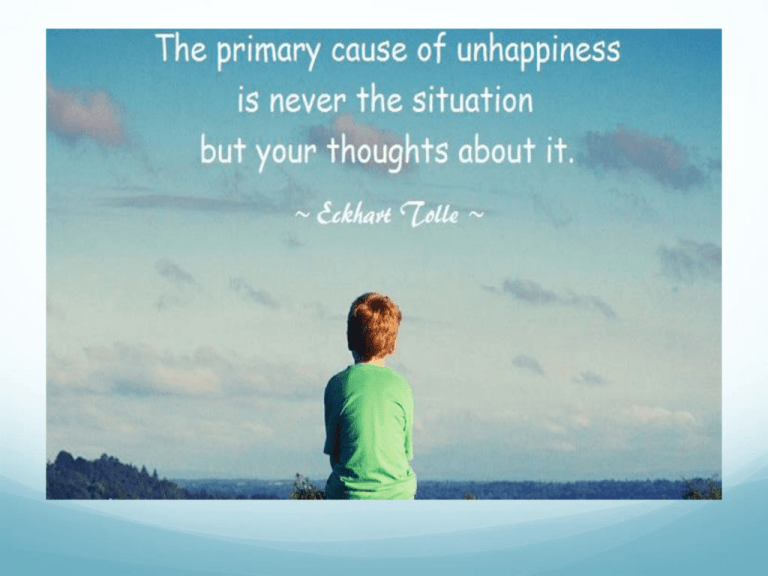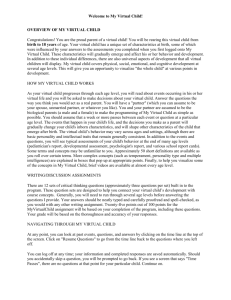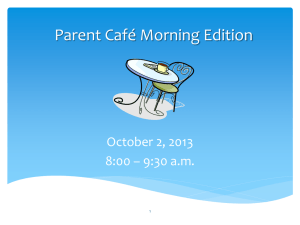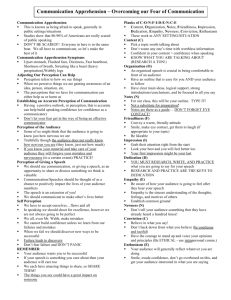Reducing the Daily Battle – Tricia King Presentation
advertisement

Reducing the Daily Battles Strategies for increasing collaboration, cooperation and connection for families Presented for SEPAC by Tricia King, LMHC, CMHS Secondary Mental Health Specialist, NSD Overview Understand who you’re talking to: Review of cognitive developmental stages of childhood and adolescence Behavior background Creating Collaboration: How to set the stage for partnership and success When the wheels come off: How to recognize when collaboration has eroded and how to revive it. Who am I talking to??? Stages of cognitive/intellectual development and their primary features (Jean Piaget) Sensorimotor Stage (birth-2 years): Child understands the world through senses and movements; understands they are separate from caregivers; understands that (s)he can cause things to happen. Preoperational Stage (2-7 years): Child begins to think symbolically and use words and pictures to represent object. Child is egocentric (can only see from her/his point of view) and can only think about things in concrete terms. Concrete-Operational Stage (7-11 years): Child begins to think logically about concrete events; thinking becomes logical and organized but still concrete. Child may begin using inductive logic (generalizing from the specific information to a general principle) Formal Operational Stage (age 12 and up): Child begins to be able to think abstractly and about hypothetical situations. Child may be thinking about moral, ethical, social and philosophical issues. Begins to utilize deductive logic (reasoning from a general principle to specific situation). Who Am I talking To? (Cont.) Erik Erikson Psychosocial Stages (see chart in handout): Erikson was a contemporary and student of Freud who later broke away and created theories of development and personality. Pay attention to the developmental tasks at each stage. Try to think about the conflicts that you have with your child(ren) within the context of these tasks. Behavior Background Alfred Adler’s personality theory and “individual psychology” emphasized the importance of the social environment on individual personality development and behavior. Core concepts include: the emphasis on how perceptions of inferiority/superiority influence human behavior and experience AND that behavior is purposeful and directed toward creating connection to the social environment and meaning. All are equal in striving for meaningful connection and purpose. More Behavior Background Behavior is purposeful and usually directed at the goals of belonging and meaning (significance) People make decisions based on their perceptions of the world: Perception=>Interpretation=>Belief=>Decision • Most behavior is a “solution” to a problem or perception • The mis-behaving child is a discouraged child Using Behavior Background in Parenting and Conflict Management (Terry Chadsey, President, Sound Discipline) Tools from Adler’s Ideas: Teach life skills Pay attention to the power of perception Focus on encouragement through meaningful connection (not just praise) Hold both kindness and firmness in interactions and negotiations. Mutual respect is key: respect for yourself and the situation (firmness) and respect for the needs of the child and others (kindness) Look for solutions rather than punishments (but allow natural consequences) Criteria for Effective Discipline (Jane Nelson, www.positivediscipline.com) Helps Children feel a sense of connection (Belonging and significance) Is mutually respectful and encouraging (Kind and firm) Is effective in the long-term (Considers what the child is thinking, feeling, learning and deciding about himself and the world-and what to do in the future to survive and thrive) Teaches important social and life skills (Respect, concern for others problem solving and cooperation as well as the skills to contribute to home, school or larger community) Invites children to discover how capable they are (Encourages the constructive use of personal power and autonomy) Creating Collaboration Prioritize your own needs: Rank the areas of conflict from those with the greatest need for attention to the least. Issues related to personal safety always come first. (Fearbased parenting vs. love-based parenting: Identify your own motivation) Choose the top two areas of conflict to address (small bites are important) Armed with your new understanding of developmental stages and theories of human behavior, open a conversation about the conflicts with your child in a moment of calm Contracts Co-create agreements with your child (remember developmental stage; be ready to negotiate) Ask your child about her perception of the problem (perception often drives behavior!) Share your perception using emotional neutrality (just the facts, ma’am) Identify mutual goals (e.g.” I would like your help and you would like for me not to nag you”) Create a contract (set of explicitly defined behaviors) that meets mutual goals): e.g. “You will have your homework finished by 6:00 p.m. and I will leave you alone to play video games until 8:00 after that” Write it up and post it! Lists can be your friend. Correction Use emotional neutrality as much as possible Remember the kindness and firmness balance and mutual respect (empathy and natural consequences are effective teachers). Empathy keeps the child’s focus on learning from the mistakes, rather than on the adult emotional response to the mistake. Refer to the contract if you have one Offer choices as much as possible Remember that mistakes are opportunities to learn for all involved (these may lead to revisiting your contract for finetuning): Your anger does not teach your child. Correction (Cont.) Allow your child to experience the natural consequences of behavior, including feeling bad about it Stay in the present moment (no sand-bagging!) When re-directing, use statements (no questions or accusations, please) Embrace and acknowledge your child’s feelings (“I can see you feel really____”) Be ready to disengage, take a break to cool down and return (Is this a situation that must be resolved right now?) Consistency, consistency, consistency! Turn Conflicts into Cooperation (Cynthia Ulrich Tobias) Choose your battles: Conflict is reduced overall. Decide what issues are worth it (Safety? School? Table manners?). Once you have chosen, stay committed to getting there, but flexible about how. Lighten up, but don’t let up: I have a sense of humor and I’m not afraid to use it! Ask more questions, issue fewer orders: Which one gets a positive response from you when you receive it; a question or an order? (Emotional neutrality is important here. Stay specific: questions like “Why did you do that?” and “What were you thinking?” destroy connection) Hand out more tickets; give fewer warnings: When correction is called for, give it and walk away. Deliver the consequences and avoid the lecture. Consistency is key. Make sure your child always knows that your love is unconditional: This keeps the need for connection satisfied and allows focus on the behavior. When the Wheels Come Off: Collaboration breakdown and restoration It takes courage to admit it isn’t working: This is an opportunity for powerful modeling for your child Timing is everything: Set the stage for success by choosing the right moment to address the problem Solicit your child’s help: Elicit your child’s inner critic to tackle and help solve the problem Be prepared to abandon an approach that isn’t working, but not the issue itself: Parents get discouraged, too. Seek support and stick with it! Your persistence communicates the importance of the issue to your child. Wrap It Up and Take It Home! There is no one “right” answer: Have empathy for yourself as well as your child. Parenting is a “work in progress”. Remember that your children are resilient beings who, with your help and guidance, can recover from mistakes (both yours and theirs!) and keep on growing. Seek community and support for yourselves. Empty pitchers can not fill the glasses of others. References Theories of Psychotherapy and Counseling, 5th Edition (2011). Richard S. Sharf. Leading Classrooms with Courage and Connection (August, 2012). Judy McVittie (facilitator), Sound Discipline (SoundDiscipline.org). You Can’t Make Me (But I Can Be Persuaded): Strategies for Bringing Out the Best in Your StrongWilled Child. (1999, 2012). Cynthis Ulrich Tobias. Becoming a Love & Logic Parent. (1991, 2000). Jim Fay; Foster W. Cline, M.D.; and Charles Fay, Ph.D.








